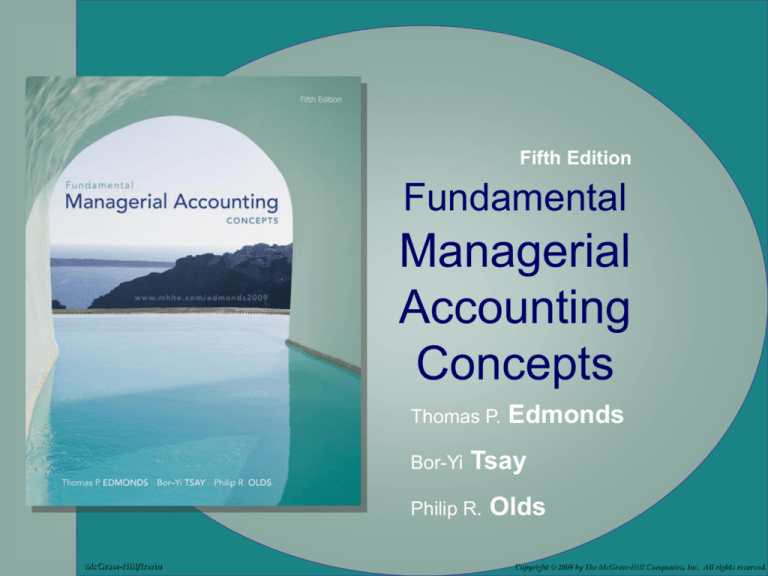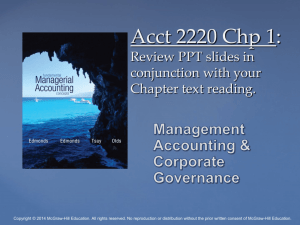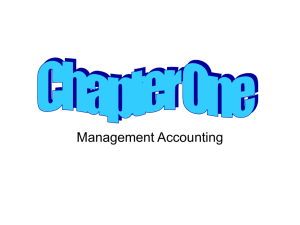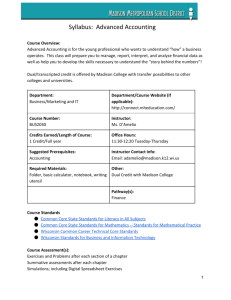
Fifth Edition
Fundamental
Managerial
Accounting
Concepts
Thomas P.
Bor-Yi
Tsay
Philip R.
McGraw-Hill/Irwin
Edmonds
Olds
1-1
Copyright © 2009 by The McGraw-Hill Companies, Inc. All rights reserved.
CHAPTER 1
Management
Accounting and
Corporate
Governance
1-2
Learning Objective
Distinguish
between
managerial and
financial
accounting.
LO1
1-3
1-4
1-5
Learning Objective
Identify the cost
components of a product
made by a manufacturing
company: the cost of
materials, labor, and
overhead.
LO2
1-6
Product Costs in
Manufacturing Companies
Materials
Labor
Overhead
1-7
1-8
Average Cost per Unit
Total Cost
Number of Units
= Average Cost per Unit
Tabor Example Average Cost Per Unit
$1,000
= $250
4
1-9
Costs Can Be Assets or
Expenses
Product
Cost
Period
Cost
Asset
COGS
Expense
1-10
1-11
Learning Objective
Explain the effects on
financial statements of
product costs versus
general, selling, and
administrative costs.
LO3
1-12
Patillo Manufacturing
Company Transactions
Patillo Manufacturing Company experienced the following transactions:
Event 1
Event 2
Event 3
Event 4
Event 5
Event 6
Event 7
Event 8
Event 9
Event 10
Acquired additional $15,000 cash by issuing common stock.
Paid $2,000 for the materials that were used to make its products. All
products started were completed during the period.
Paid $1,200 for salaries of selling and administrative employees.
Paid $3,000 for wages of production workers.
Paid $2,800 for furniture used in selling and administrative offices.
Recognized depreciation expense on office furniture purchased in Event
5. The furniture acquired on January 1 had a $400 estimated salvage value
and a four-year useful life. The annual depreciation charge is $600
[($2,800 - $400)/4].
Paid $4,500 for manufacturing equipment.
Recognized depreciation expense on equipment purchased in Event 7.
The equipment acquired on January 1 had a $1,500 estimated salvage
value and a three-year useful life. The annual depreciation charge is
$1,000 [($4,500 - $1,500)/3].
Sold inventory to customers for $7,500 cash.
1-13
The inventory sold in Event 9 cost $4,000 to make.
1-14
Labor Costs
1-15
Overhead Costs
1-16
Total Product Cost
1-17
1-18
Overhead Costs: A Closer
Look
Indirect Costs
Depreciation
Supervisor’s
Salary
Utilities
1-19
Indirect Cost Allocation
1-20
Manufacturing Cost Summary
Direct
Materials
Direct
Labor
Manufacturing
Overhead
Raw material
costs that can
be easily traced
to products.
Factory wages
that can be easily
traced to products.
Other factory costs
such as indirect
materials and labor,
utilities, rent, security,
and depreciation.
1-21
Learning Objective
Distinguish
product costs from
upstream and
downstream costs.
LO4
1-22
Upstream and Downstream
Costs
Upstream
Downstream
Costs
Costs
Occur before the
manufacturing
process begins.
Occur after the
manufacturing
process begins.
1-23
Learning Objective
Explain how product
costing differs in
service,
merchandising, and
manufacturing
companies.
LO5
1-24
Product Costing in Service and
Merchandising Companies
Service
Companies
Merchandising
Companies
Provide products to
customers that are
consumed immediately
Sell products other
companies make
Service and merchandising companies also incur labor
and overhead costs. However, these costs are normally
treated as general, selling and administrative expenses
rather than accumulated in inventory accounts.
1-25
Learning Objective
Explain how justin-time inventory
can increase
profitability.
LO6
1-26
Just-in-Time
Many businesses have been able to simultaneously
reduce their inventory holding costs and increase
customer satisfaction by making products available justin-time (JIT) for customer consumption.
For example, hamburgers
that are cooked to order
are fresher and more
individualized than those
that are prepared in
advance and stored until a
customer orders one.
1-27
Corporate Governance
Corporate governance is a set of relationships between
the board of directors, management, shareholders,
auditors, and other stakeholders that determine how a
company is operated.
Management
Board of Directors
Auditors
1-28
Learning Objective
Identify the key
components of
corporate
governance.
LO7
1-29
The Motive to Manipulate
Strong Financials
Weak Financials
Promotions
Pay raises
Bonuses
Stock options
Passed over for promotions
Demoted
Fired
1-30
Marion Manufacturing
Company
Marion Manufacturing Company (MMC) had the
following transactions:
1. MMC was started when it acquired $12,000 from
issuing common stock.
2. MMC incurred $4,000 of costs to design its
product and plan the manufacturing process.
3. MMC incurred specifically identifiable product
costs of $8,000.
4. MMC made 1,000 units of product and sold 700 of
the units for $18 each.
Let’s look at two scenarios for MMC.
1-31
Marion Manufacturing
Company
Scenario 1
Scenario 2
The $4,000 of design
and planning costs are
classified as selling
and general and
administrative.
The $4,000 of design
and planning costs are
classified as product
costs, meaning they
are first accumulated
in the inventory
account and then
expensed when the
goods are sold.
1-32
1-33
Ethical Considerations
Certified Management Accountants are
guided by the IMA Statement of Ethical
Professional Practice
The statement provides standards on
Competence
Confidentiality
Integrity
Credibility
Resolution of ethical conflict
1-34
Common Features of Criminal
and Ethical Misconduct
Opportunity
Fraud
Triangle
Pressure
Rationalization
1-35
Internal Control Practices
Hiring
Competent
Personnel
Separating
Duties
Requiring
Extended
Absences
Using
Prenumbered
Documents
Establishing
Physical
Controls
Bonding
Employees
Establishing
Clear Lines of
Authority &
Responsibility
Performing
Evaluations at
Regular
Intervals
1-36
Sarbanes-Oxley Act of 2002
Internal
Controls
CEO and
CFO
Certification
Code of
Ethics
Hotline for
Anonymous
Reporting
1-37
Learning Objective
Identify emerging
trends in
accounting.
(Appendix A)
LO8
1-38
Benchmarking: Identifying Best
Practices of Global Competitors
Total Quality
Management
(TQM)
Activity-Based
Management
(ABM)
Comprehensive
Value Chain
Analysis
1-39
End of Chapter 1
1-40









